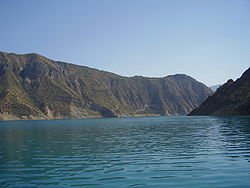Vakhsh River
| Vakhsh River | |
|---|---|

The Vakhsh River (highlighted in blue)
|
|
| Country | Kyrgyzstan, Tajikistan |
| Basin | |
| River mouth | Amu Darya |
| Basin size | 39,100 km2 (15,100 sq mi) |
| Physical characteristics | |
| Length | 786 km (488 mi) |
| Discharge |
|
| Nurek | |
|---|---|

The Vakhsh River forms a reservoir behind the Nurek dam.
|
|
| Coordinates | 38°22′N 69°21′E / 38.367°N 69.350°ECoordinates: 38°22′N 69°21′E / 38.367°N 69.350°E |
The Vakhsh (River) (Tajik: Вахш, Vaxş), also known as the Surkhob (Сурхоб), in north-central Tajikistan, and the Kyzyl-Suu (Kyrgyz: Кызылсуу, Kızılsuu/Qьzьlsuu), in Kyrgyzstan, is a Central Asian river, and one of the main rivers of the nation of Tajikistan. It is a tributary of the Amu Darya river.
The river flows through the Pamirs, passing through very mountainous territory that frequently restricts its flow to narrow channels within deep gorges. Some of the largest glaciers in Tajikistan, including the Fedchenko and Abramov glaciers (the former of which is the longest glacier in the world outside of the polar regions), drain into the Vakhsh. Its largest tributaries are the Muksu and the Obihingou; the Vakhsh River proper begins at the confluence of the Obihingou and Surkhob rivers.
After it exits the Pamirs, the Vakhsh passes through the fertile lowlands of southwest Tajikistan. It ends when it flows into the Panj River to form the Amu Darya, at the border of Tajikistan and Afghanistan. The Tigrovaya Balka Nature Reserve, which was the last habitat of the now-extinct Caspian tiger in the former USSR, is located at the confluence of the Vakhsh and the Panj.
The catchment area of the Vakhsh is 39,100 km2, of which 31,200 km2 (79.8%) lies within Tajikistan. The river contributes about 25% of the total flow of the Amu Darya, its parent river. Its average discharge is 538 m3/s, with an annual discharge of 20.0 km3. However, since the Vakhsh is fed mostly by melting snow and glaciers, these flow rates have great seasonal variability between winter and summer. Measurements at the Nurek Dam indicate that winter flow rates average around 150 m3/s, whereas flow rates during the summer months can exceed 1500 m3/s – a tenfold increase.
...
Wikipedia
